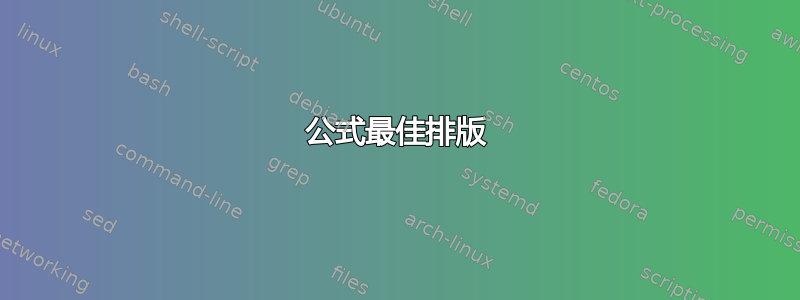
考虑以下示例。
\documentclass{article}
\usepackage{amsmath}
\newcommand*\mathsetfont{\mathbf}
\newcommand*\DeclareMathSet[1]{%
\expandafter\newcommand\csname set#1\endcsname{\mathsetfont{#1}}
}
\DeclareMathSet{N}
\DeclareMathSet{Q}
\begin{document}
\begin{align*}
&\{1983/4, 1985/4, 1986/4, 1987/4, 1989/4, 1990/4, 1991/4,\\
&\hphantom{{}\{} 1993/4, 1994/4, 1995/4, 1997/4, 1998/4, 1999/4\}
\subseteq \setQ\setminus\setN.
\end{align*}
\end{document}

排版此公式的最佳方法是什么?
我之所以问这个问题,是因为我觉得我的尝试看起来有些“奇怪”,因为\subseteq \setQ\setminus\setN它就在下面开始1991/4。
答案1
我的个人座右铭是如果我要传达一个明确的信息,最好让它显而易见
\documentclass{article}
\usepackage{amsmath,array}
\usepackage{xcolor,cancel}
\newcommand*\mathsetfont{\mathbf}
\newcommand*\DeclareMathSet[1]{%
\expandafter\newcommand\csname set#1\endcsname{\mathsetfont{#1}}
}
\DeclareMathSet{N}
\DeclareMathSet{Q}
\begin{document}
\[
\left\{
\begin{array}{c@{,}c@{,}c@{,}c@{,}}
\ldots &\ldots &\frac{1983}{4} &\cancel{\textcolor{red}{\frac{1984}{4}}}\\[1ex]
\frac{1985}{4} &\frac{1986}{4} &\frac{1987}{4} &\cancel{\textcolor{red}{\frac{1988}{4}}}\\[1ex]
\frac{1989}{4} &\frac{1990}{4} &\frac{1991}{4} &\cancel{\textcolor{red}{\frac{1992}{4}}}\\[1ex]
\frac{1993}{4} &\frac{1994}{4} &\frac{1995}{4} &\cancel{\textcolor{red}{\frac{1996}{4}}}\\[1ex]
\frac{1997}{4} &\frac{1998}{4} &\frac{1999}{4} &\ldots
\end{array}
\right\}\subseteq \setQ\setminus\setN.
\]
\end{document}

您实际上可以创建一个新的列类型以简化输入。但我总是将自己与>{}、<{}组混淆。这次文本的块选择似乎更容易了 :)
编辑:转换为一个序列,以便数学上敏感的人不会受到太大的冒犯。
答案2
以下是另外两种方法:

代码:
\documentclass{article}
\usepackage{amsmath}
\newcommand*\mathsetfont{\mathbf}
\newcommand*\DeclareMathSet[1]{%
\expandafter\newcommand\csname set#1\endcsname{\mathsetfont{#1}}
}
\DeclareMathSet{N}
\DeclareMathSet{Q}
\begin{document}
The equation:
\[
\left\{ \frac{y}{4} \right\} \subseteq \setQ\setminus\setN
\]
where $y \in \{ 1983, 1985, 1986, 1987, 1989, 1990, 1991, 1993, 1994, 1995, 1997, 1998, 1999 \}$
\bigskip
\hrule
\bigskip
If we let $Y = \{ 1983, 1985, 1986, 1987, 1989, 1990, 1991, 1993, 1994, 1995, 1997, 1998, 1999 \}$, then
\[
\left\{ \frac{y}{4} \,\middle|\, y \in Y\right\} \subseteq \setQ\setminus\setN
\]
\bigskip
\hrule
\bigskip
The set $Y$ could also be expressed as
\[ Y = \{ n \in \setN \mid 1983 \le n \le 1999 \} \setminus \{ 1984,1988,1992,1996\} \]
\end{document}
答案3
再看一遍...非常科学的视角:
\documentclass{article}
\usepackage{amsmath}
\newcommand{\mathsetfont}{\mathbf}
\newcommand{\DeclareMathSet}[1]{%
\expandafter\newcommand\csname set#1\endcsname{\mathsetfont{#1}}
}
\DeclareMathSet{N}
\DeclareMathSet{Q}
\begin{document}
\[ \{n/4\mid n\in [1983, 1999]\setminus\{1984,1988,1992,1996\} \cap \setN\}\subseteq \setQ\setminus\setN \]
\end{document}

编辑:...或者你甚至可以完全取消任何明确的数字枚举,如果这是你想要的:
\[ \{n/4\mid n\in [1983, 1999] \cap \setN\ \land n \neq 4m \mid m \in \setN\}\subseteq \setQ\setminus\setN \]

答案4
关于什么:

\documentclass{article}
\usepackage{amsmath}% http://ctan.org/pkg/amsmath
\newcommand*\mathsetfont{\mathbf}
\newcommand*\DeclareMathSet[1]{%
\expandafter\newcommand\csname set#1\endcsname{\mathsetfont{#1}}
}
\DeclareMathSet{N}
\DeclareMathSet{Q}
\begin{document}
\begin{align*}
&\{1983/4, 1985/4, 1986/4, 1987/4, 1989/4, 1990/4, 1991/4,\\
&\hphantom{{}\{} 1993/4, 1994/4, 1995/4, 1997/4, 1998/4, 1999/4\}
\subseteq \setQ\setminus\setN.
\end{align*}
\begin{align*}
\{y/4 \mid y \in \{1983,\dotsc, 1999\} \setminus \{1984,1988,1992,1996\}\}
\subseteq \setQ\setminus\setN.
\end{align*}
\end{document}
您甚至可以考虑使用\{\text{leap year}\}而不是\{1984,...,1996\}。


